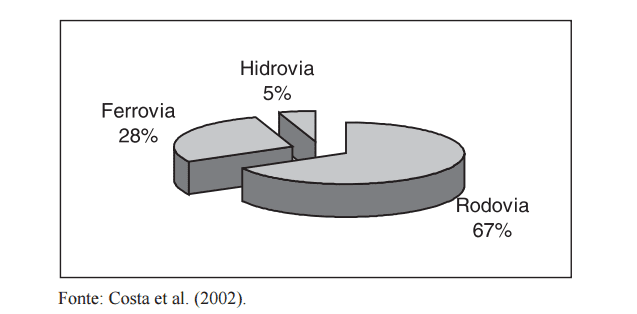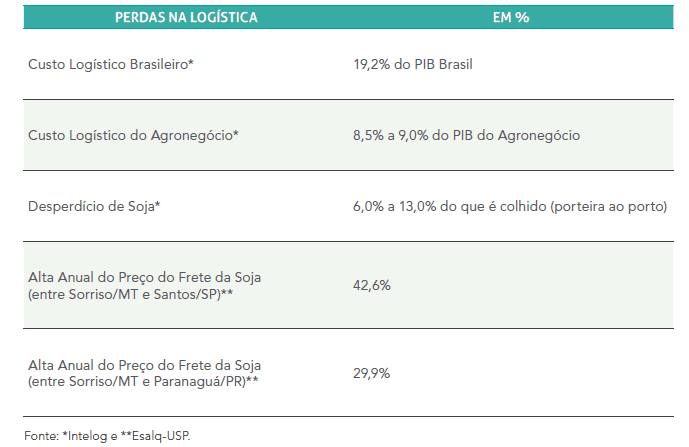REVIEW ARTICLE
SOUZA, André Luiz Alvarenga De [1]
SOUZA, André Luiz Alvarenga De. Logistics in agribusiness production chains. Revista Científica Multidisciplinar Núcleo do Conhecimento. 04 year, Ed. 08, Vol. 06, pp. 33-54. August 2019. ISSN: 2448-0959
SUMMARY
The present work is developed under the context of Brazilian agribusiness, more specifically focusing on the logistics of productive chains. Through a bibliographic review through secondary sources (books, periodicals, articles, scientific papers and websites). The treatment of the same is used in qualitative methodology with some quantitative analysis. Under the motivation of the problem, are the main problems encountered by agribusiness in Brazilian logistics its challenges and its perspectives allied to a review article.
Keywords: logistics, agribusiness, production chains.
1. INTRODUCTION
The social, economic and market changes in recent years worldwide have made the globalized agribusiness established with an unusual character from years ago. Brazil facing all this globalization must continue to produce food for the Brazilian people and other nations of the planet.
What worries is that the world will need more and more food and Brazil has a great potential to meet this demand, because it has great natural resources which the country has in abundance, but due to the modal transport system that is used tends to lose g Rande part of their loads, leaving the food increasingly expensive.
Brazil is established today in the current world context, as a barn of wealth in terms of agribusiness. According to Rodrigues (2006), the country has 22% of the world’s farmland, in addition to the high technology used in the field, data that make the Brazilian agribusiness a modern, efficient and competitive sector in the international scenario.
“Agribusiness is the largest global and Brazilian business in the world, represents the generation of U $6.5 trillion/year and, in Brazil, around R $350 billion, or 26% of GDP (29%, according to the National Confederation of Agriculture CNA)”. (STEFANELO, 2002, p.10)
Most of the business is outside the porters, covering the supplies, the processing of raw materials and the distribution of products. For (STEFANELO, 2002), these are points that reinforce the importance of agribusiness in Brazil, besides its great competitiveness and use of high technology, being propellant of development, income and jobs.
Agribusiness is still responsible for a large part of the human resources used throughout the chain, since we have from the staff who handle the seeds, plant, harvest, store, benefit, transport until reaching the final consumer. However in regions not so developed, the sectors of agriculture, agro industrialization and corresponding areas will be important for the growth of income and employability, (RENAI, 2007, CARLOS LOURENÇO Y BARBOSA DE LIMA).
Brazil is an international highlight in terms of agribusiness production, but logistics infrastructure is one of its biggest obstacles to the development of agribusiness in Brazil that is directly connected to the road network.
CNT National Confederation of Transport (2014), Brazil is the 2nd largest exporter of soybeans and corn in the world. In 2014, 46 million tons of soybean and 19.5 million tons of corn were exported.
In view of this scenario there are still some problems related to the flow of the entire crop, only the conditions of the pavement of highways lead to an increase of 30.5% in the operating cost. If the
Additional expenses due to this bottleneck, there would be an annual economy of R $3.8 billion (CNT National Confederation of Transport,2014).
Agribusiness in Brazil represents to the economy great advances to the country, placing it in a search for a structure to become efficient and competitive in the face of the opportunities and threats that arise in the sector.
The aim of this study is to analyze logistics in the agribusiness productive chains through bibliographic research, demonstrating through official data and sources how important is agribusiness and the road transportation system in Brazil.
2. LITERARY REVIEW
2.1 LOGISTIC: THE CONCEPT
The concept of logistics is reinforced by (Carvalho, 2002, p. 31)
“Logistics is the part of supply chain management that makes planning, implementations and connects to the efficient and economical flow and storage of raw materials, semi-finished products and finished products, it is inferred from its origin to the Consumption point, with the purpose of meeting customers ‘ requirements. “
Historically, logistics has emerged from the military’s expertise in supplying armaments, ammunition, medicine and food while moving from its base to other battle-line positions.
Logistics is engendered by the flow of supplies and information that unfold during the entire period of transformation of the raw material, as well as the inverse path it can make.
Second (BALLOU, 2006), business logistics can be defined as the integrated management of the areas of finance, marketing and production within the company in the course of the logistic process.
Another important point to be highlighted is the Supply Chain Management focused on a management strategy that enhances companies to be more dynamic and thus to promote market competitiveness, due to the use of integrated technologies the chain of Supplies.
(POZO, 2010), Supply Chain Management (SCM) Supply chain management, has represented a new and promising frontier for companies interested in obtaining competitive advantages in an effective way.
Given the new perspectives of the 21ST century and the growing demand for products, Supply Chain Management becomes essential for all companies regardless of size or branch of activity.
Nowadays, logistics is highlighted, because in view of the current Brazilian conjuncture, business managers perceived the great importance of this important topic. Its importance for agribusiness is evident and has been felt over time through each harvest harvested.
2.2 AGRIBUSINESS: CONCEPT
The term agribusiness is directly associated with the concept of agribusiness that arises in 1957, with John Davis and Ray Goldberg, North American researchers.
The concept of Agribusiness is “the sum of the operations of production and distribution of agricultural supplies, of production operations in the agricultural units, of the storage, processing and distribution of agricultural products and items produced from them”. (CRUVINE; MARTIN NETO, 1999)
In order to the term used by John Davis and Ray Goldberg It is also understood that agribusiness is the sum total of all operations made inside and outside the farm and involving the production of agricultural supplies and subsequently processing and distribution of products.
In Brazil, the concept emerged in the years 1980 with the nomenclature “Agroindustrial complex” that later over the years evolves to agribusiness.
Among several expressions already found about agribusiness, what matters is the concept that it aggregates that is a business or family-based agribusiness involving the entire production chain. Within the context there are also explanations related to the situations posed by John Davis and Ray Goldberg who are “the Before the Doorholder, the inside the gate and the after the gate of the property”.
The explanation of these items is related to the acquisition of seeds, seedlings, fertilizers, agrochemicals, tractors and implements that means (before the gate) the other aspect is represented by the production itself of coffee, soy, corn, rice, Beans, livestock, agro-tourism, among others, this is the (inside the gate) and the beneficiation, transportation, storage, processing or industrialization, commercialization is the (after the gate). All this needs transportation systems to be locomoting, which also generates great impact throughout the chain due to the high cost related to the transportation of inputs and products in Brazil.
Within the aspects of agribusiness it is worth resaltar the productive chains because they are considered as the set of all those involved in the processes that involve a particular product from its conception to reach the consumer. Each of the operations compose one called “Elo”, which forms a long chain referring to thinking of chaining.
This focus is to describe the production operations responsible for transforming the raw material into finished or semi-finished products. According to this logic, a production chain is presented as a linear succession of technical production operations. (BATALHA, 2001)
If we think that everything that is produced, needs to be transported, sold and bought by consumers, we can think about the wholesale, because it has the function of distributing food to urban centers, as well as retail.
Such distribution goes through central platforms that have had the role of physically concentrating the product and allowing retailers to supply themselves. (ZYLBERSZTAJN, 2005)
The markets do not work without costs, or at zero cost and starting from this premise, we know that nothing is free of course and the farmers need to somehow organize the disposal of their production units in order to optimize time and money.
In view of this position that the markets have costs in relation to their operation, the possibility of expanding the neoclassic precepts of cost minimisation, which considers only the measurable costs of the production factors, also incorporates the Transaction costs. (ZYLBERSZTAJN, 2005)
3. LOGISTICS IN AGRIBUSINESS PRODUCTIVE CHAINS
Agribusiness is one of the largest businesses in the Brazilian economy, if not the largest, since it globally falls into a world economy niche. In the year 2014 moved more than 1.1 trillion reais, being 23% of GDP (BLOG OF the PLATEAU OF the PRESIDENCY of the REPUBLIC, 2014).
Brazil is considered to be one of the countries with the highest agricultural potential worldwide, to expand exports of products related to agribusiness, in prominence, those linked to food and energy, such as alcohol and bio diesel, but faces Large internal difficulties due to the modal system inserted in the transport policy, (site agribusiness Portal, 2004).
As regards transport, the road freight market in Brazil, and in particular agricultural cargo, does not suffer any kind of control by the Government, this means that prices are formed based on the free negotiation between supply and demand for Shuttle service. (CAIXETA-FILHO, 1998),
Brazil is still largely used in the road transport model to drain production, which generates costs throughout the productive chain.
It states that the soybean crop is undoubtedly the most destabilizing the freight market, that is, with the intensive use of transport services, as the available vehicles become scarce and the freight values increase significantly. (CAIXETA-FILHO, 2001)
However, we cannot apply the concept of agribusiness only to large corporations, but to all the links of this current that is responsible for bringing agribusiness products to the hands of those who consume it.
The federal government announced in 2015, investments of R $198.4 billion in the coming years, also stressed the new phase of the Logistics Investment Program (PIL), and that will privatize airports, highways, railways and ports (website of the Presidency of the Republic, 2015) .
The great impact of these measures comes from meeting the precarious agricultural policies, poor yield of the production units without talking about the lack of adequate structural support, and the great decline in profitability of a business that weighs heavily on Brazilian trade balance directly affecting GDP.
It is known, then, that when there is quality transport infrastructure the efficiency of the agro-industrial system is higher, being preponderant in the cost of moving products. The logistics of transport in agribusiness
Has great prominence because it has a great impact on the determination of the prices paid to the producer.
Another aspect of strangulation faced by the sector is the lack of other models of modal flow of production to the detriment of the road.
In the case of agricultural products (solid bulk), the modal concentration is very inadequate, the road being responsible for 80% of the loads, the rail, 8-10%, and the waterways stay with the remainder. (CAIXETA-FILHO, 2001)
The figure shows the inadequacy for the cases of movement of soybean loads in Brazil. (COSTA, 2002)
Figure 1: Transport matrix for the soybean complex in Brazil:
The soybean crop, which occurs between the months of March and April, is the one that most destabilizes the freight market in Brazil. Another fact also important to highlight, this negative fact, is the slowness between the property of agricultural production and the industry, leading to a demand of greater need for maintenance of the truck, usually these pathways are vicinal and unpaved, summing All of these are factors that also elevate freight costs. (SOARES 1997).
Figure 2: Logistics of the distribution of derived grains in Brazil
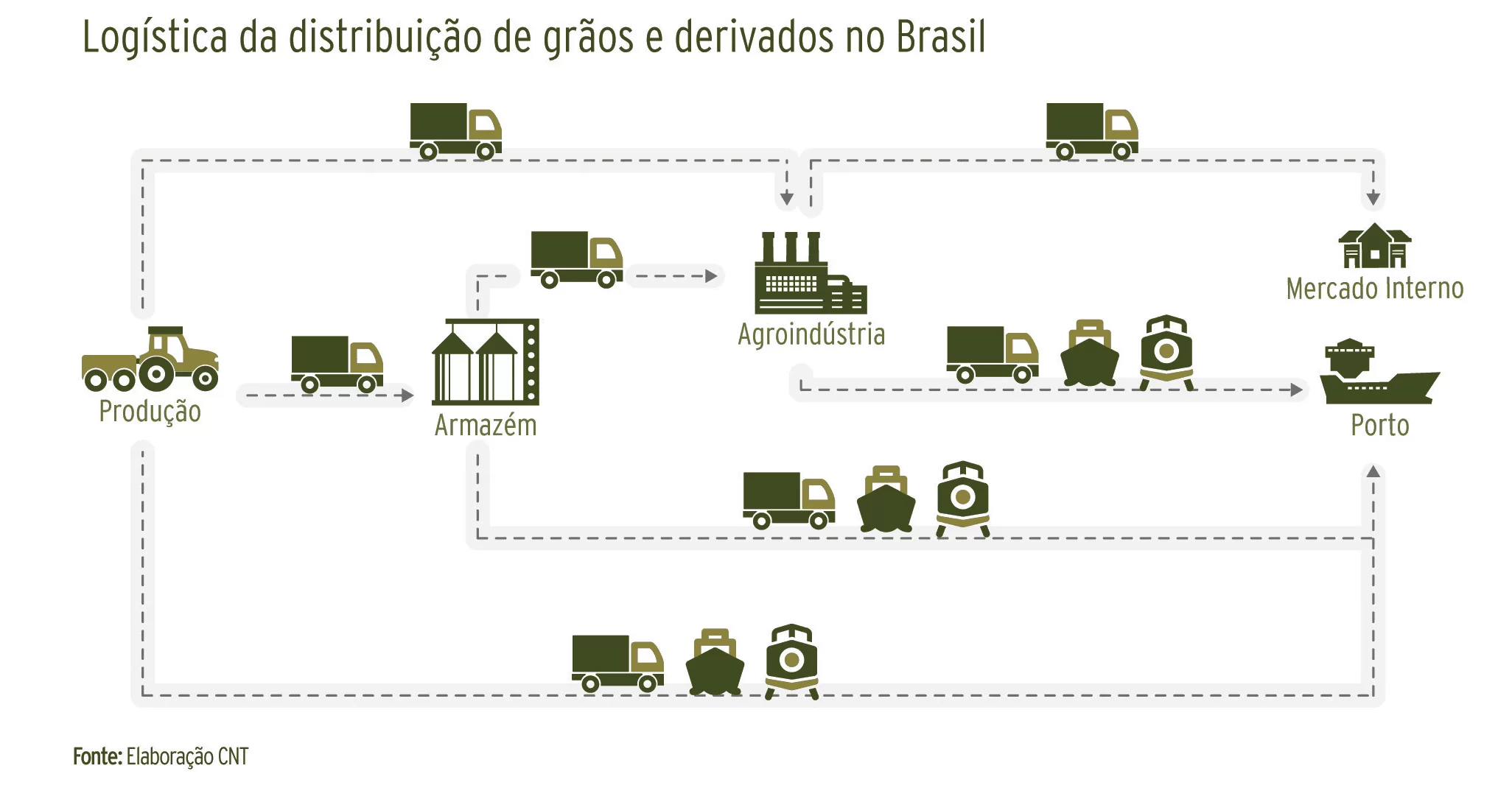
The agribusiness balance held by the CONFEDERATION OF AGRICULTURE and LIVESTOCK OF BRAZIL (CNA, 2013 and 2014), in recent years, agribusiness stood out as a preponderant factor for the economic growth of the country.
The performance could be better, if not the costs and the waste generated by the lack of infrastructure and logistics in Brazil. According to data from (INTELOG, 2013), to cover logistics expenses are spent between 8.5% and 9.0% of everything that is produced by the sector.
Bad infrastructure is also one of the main factors responsible, for example, by waste, as shown in Figure 2, with soybeans. It is estimated that grain loss, from crop to port, varies between 6.0% and 13.0%.
Figure 3: Logistic cost
4. METHODOLOGICAL ASPECTS
The methodological aspects aim to describe the procedures used to achieve the objectives proposed at work. It was initiated by describing the methods used in the operationalization of the theoretical research, then presenting the research techniques, the research universe, and the procedures of data collection.
Among the various forms of the researcher fostering knowledge there are different types of research that directly imply in different procedures in terms of formulating research questions, methods and analyses.
According to (FLEMING 2008, p. 69, MATTAR 1996), “There are several possible classifications of types of research, because the type of research is a complex concept that cannot be described in a unique way.”
This research can be classified as a theoretical essay written from a bibliographic review, systematization and analysis of information already published regarding the topic “LOGISTICS OF AGRIBUSINESS”.
The nature of the research, characterized as basic, aims to generate new knowledge, useful for the advancement of science, without practical application foreseen, involves truths and universal interests. (GERHARDT e SILVEIRA, 2009)
Its aspect of addressing the problem, is framed as qualitative for the analysis of the theme and selection of articles and as quantitative for the other analyses.
Martins and Teóphilo (2007) affirm that qualitative evaluation is characterized by the description, comprehension and interpretation of facts and phenomena. Qualitative research describes the complexity of a given problem, analyzes the interaction of variables, understands and classifies the dynamic processes presented.
The quantitative approach, is widely used in the scope of researchers, (CRESWELL 2007, p. 24), defines quantitative research as a “careful observation and measurement of objective reality”.
We can consider the objective of this study as exploratory, as it aims to increase knowledge in relation to the theme, providing greater familiarity with the problem in order to make it explicit. (SILVA e MENEZES, 2005)
For the development of this research were also used secondary data, the data used are from the Ministry of Agriculture, Livestock and supply and National Confederation of Transport (CNT).
According to Malhotra (2001), the use of secondary data is justified by virtue of its wide scope and ease of access.
The articles that served as the basis for this research were selected in the Google “Scholar” database. To identify the articles referring to the theme, the keywords “AGRIBUSINESS LOGISTICS” were used. At first, the theme name of the article “LOGISTICS IN the AGRIBUSINESS PRODUCTIVE CHAINS” was used, but the research found nothing of relevance that could compose some sample.
At first, no restrictions were established in question for the search period, in this way, 46 (46) Articles that deal with the theme of the research and delimited with the keywords were found in the cited database, however, after a Profound analysis of these articles, some were discarded because they were not aligned perfectly with the theme of this research.
After this first filter, it was decided that the analysis would be related to the publications of the years 2014 to 2015, therefore a time window of 1 year, because the articles published in these years reflect the most current researches related to the theme and demonstrate the scenarios and Involved actors updated.
In the presentation of the research data we will discuss the results of the analysis of a sample of the data obtained from the Google Scholar base related to the theme of this study.
However, subsequently, the aforementioned articles were analyzed and the following criteria were established: quantity of articles per year; Number of authors per article; Means of dissemination of the research; The research theme and the contribution of the article.
5. DISCUSSION OF THE QUANTITY OF ARTICLES AND ANALYSIS OF RESEARCH DATA
After the temporal filter and the Descartes applied to the research, the quantity of articles found in the database for the theme “AGRIBUSINESS LOGISTICS”, resulted in 18 (eighteen) articles, 13 articles published in 2014 and 5 in 2015. The aforementioned distribution can be seen in the table below.
Table 1: Quantity of articles
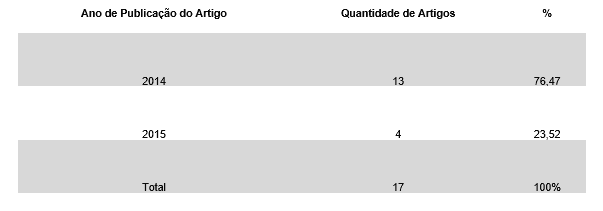
5.1 NUMBER OF AUTHORS PER ARTICLE AND MEANS OF PUBLICATION OF THE RESEARCH
Evaluating and quantifying the number of authors per article researched, that is, articles published, it appears that a substantial part of the studies are conglomerated by 1 and 3 authors, which together correspond to 76.46% of the total articles. It is clear that the works with 1 author are in more evidence representing 52.94% of the published papers.
Articles written by 2 authors correspond to a sample size of number 3 which is equivalent to 17.64% of the sample analysis, the 4 authors are even less significant, correspond to a sample size representing 5.88% of the entire set of sample data .
Table 2: Number of authors per article

Considering the analysis performed of the data, it is concluded that, most of the articles advertised within the research, results from collaboration among investigators researchers, and that this collaboration is limited between 1 to a maximum of 3 authors, being observed In the table for analyzing the quantity of authors per article.
If we observe in the table below we can verify that the Revista AGROANALYSIS-FGV, present the greatest impact factor, because it appears with 7 publications in the system researched by this study, being 4 publications in 2014 and 3 publications in 2015, until July. Referring to the other publications, the same are unique publications not possessing too many search quantifications.
Table 3: Quantity of articles and magazines
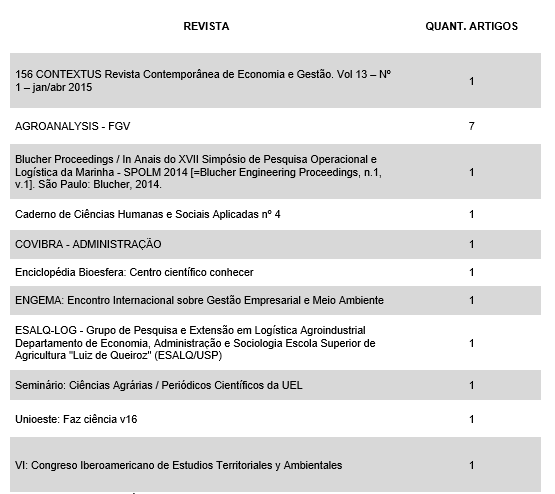
Within the theme of limitation of research were found 17 articles with various approaches related to the logistics of agribusiness and logistics in the agribusiness productive chains. The classification of the study is in the table below.
Table 4: Study classification
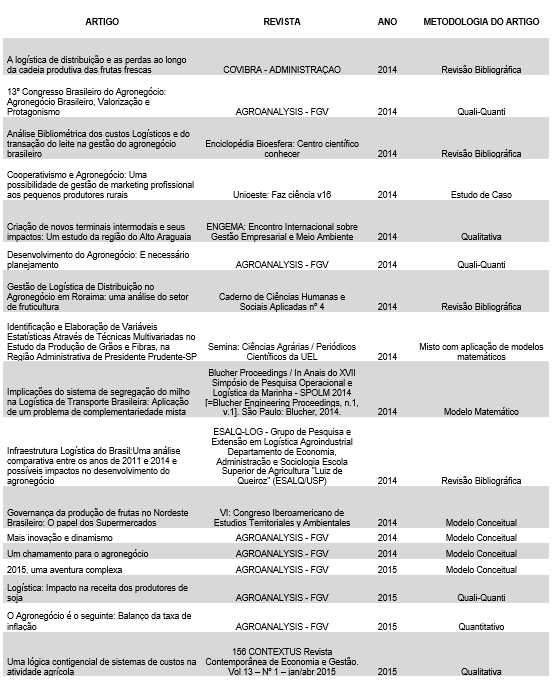
It was observed that the methodology used in the articles during the implementation of this study was that in 29.41% of the articles advertised the methodology was the case study.
Another methodology that was also noteworthy was the conceptual model and Quali-quanti both with 17.64%.
Within the temporal window of delimitation of the research for this study, it is noted that in 2014 the most used methodology was the bibliographic review corresponding to 23.53% of the articles.
In 2015 until July it was observed that no article had presented the methodological aspect of bibliographic review. The aforementioned distribution is listed in table 4.
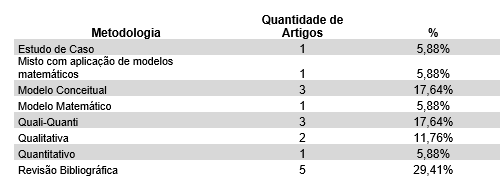
6. FINAL CONSIDERATIONS
The objective of this study was to explore and quantify scientific production in relation to the main properties of research related to logistics in the agribusiness production chain. This study contributes to the perception and mapping of the main themes addressed within the area and the main methodologies employed.
We can affirm that the research achieved its objective, since it was possible to identify, quantify and qualify articles referring to the topic and determine the trends of research in the area of logistics in the agribusiness production chain.
In view of the analyses made in this study it was observed that the authors who published articles on the subject analyzed, are limited, in few partnerships, it is observed that most published researches are composed of two to three authors.
In reference to the topics covered within the area of logistics in the agribusiness production chain, it is noted that the articles evaluated during the performance of this study focus on topics such as logistics and distribution of the production chain, logistic costs, creation of New intermodal terminals and agribusiness development.
Finally, the topic dealt with in this article is of interest to the segments of public and private companies in the agribusiness and logistics sector, being an important tool for raising awareness about the current scenario that is the logistics of the Brazilian agribusiness and its main pulsating and emergency needs.
REFERENCES
ABRALOG. <http://www.abralog.org.br/website/home/>. Acesso em: 13 jul.2015.
ALVARENGA, Antônio C. NOVAES. Antonio G. N. Logística Aplicada: suprimento e distribuição física. 3ª edição. São Paulo. Ed.Edgar Blucher ltda. 2000.
ANDRADE, M.M. Como Preparar Trabalhos para Cursos de Pós-Graduação: noções práticas. 5. ed. São Paulo: Editora Atlas 2002.
BALLOU, Ronald H. Gerenciamento da Cadeia de Suprimentos/Logística Empresarial. 5a. ed. Porto Alegre: Bookman, 2006. ,p.26
BALLOU, Ronald H. Logística Empresarial: transportes, administração de materiais e distribuição física. 1ª ed. São Paulo: Atlas, 1993.
BATALHA, M. O . Gestão Agrocinustrial. São Paulo: Atlas, 2001
BATALHA, Mário O.(coord.). Gestão Agroindustrial: GEPAI: Grupo de Estudos e Pesquisas Agroindustriais. Vol. 1. 2. ed. São Paulo: Atlas, 2001.
BAYLISS, B.Transport policy and planning: anintegrated analytical approach.Washington: The World Bank, 1996.
BEILOCK, R. et al.Road conditions, border crossing and freight rates in Europe and Western Asia. Transportation Quarterly, v. 50, n. 1, p. 79-90, Winter 1996.
BLOG DO PLANALTO. <http://blog.planalto.gov.br/assunto/ministerio-da-agricultura/ >. Acesso em: 13 jul.2015.
CAIXETA-FILHO, João V. MARTINS, Ricardo S (Org). Gestão logística do transporte de cargas. São Paulo. Ed. Atlas. 2001.
CANAL DO PRODUTOR. ttp://www.canaldoprodutor.com.br/http://www.eumed.net/cursecon/ecolat/br/>. Acesso em: 13 jul.2015.
CARLOS Lourenço y Barbosa de Lima: “Evolução do agronegócio brasileiro, desafios e perspectivas” en Observatorio de la Economía Latinoamericana, Número 118, 2009. Texto completo en <http://www.eumed.net/cursecon/ecolat/br/>. Acesso em: 13 jul.2015.
CARVALHO, José Meixa Crespo de – Logística. 3ª ed. Lisboa: Edições Silabo, 2002. ISBN 9789726182795
CARVALHO, José Crespo de – Logística, Supply Chain & Network Management. Lisboa. Ad litteram, 2003.
CHRISTOPHER, Martin. Logistics and Supply Chain Management. 4. ed. São Paulo. Cengage Learning. 2012.
CHOPRA, Sunil, Gestão da cadeia de suprimentos, estratégias, planejamento e operações / Sunil Chopra, Peter Meindl; tradução Daniel Vieira; Revisãp técnica Marilson Alves Gonçalves. 4 ed. São Paulo: Pearson Prentice Hall, 2011.
COASE, R. H. The nature of the Firm. Econômica, v. 04, n.16, p. 386-405, nov./1937.
COLLIS, J.; HUSSEY, R. Pesquisa em Administração: Um guia prático para alunos de graduação e pós graduação. 2. ed. São Paulo: Artmed, 2005.
CONFEDERAÇÃO DA AGRICULTURA E PECUÁRIA DO BRASIL CNA. Disponível em: < http://www.cna.org.br/site/agencia/>. Acesso em: 13 jul.2015.
CONFEDERAÇÃO DA AGRICULTURA E PECUÁRIA DO BRASIL CNA. Disponível em: < http://www.cna.org.br/site/pesquisa/>. Acesso em: 15 jul.2015.
______. Conceitos gerais, evolução e apresentação do sistema agroindustrial. In:
ZYLBERSZTAJN, Decio; NEVES, Marcos F. (Org.). Economia e gestão dos negócios
agroalimentares. 1. ed. São Paulo: Pioneira Thomson, 2005. p. 01-21.
CRESWELL, J. W. Projeto de Pesquisa. Porto Alegre: Artmed, 2010.
CRUVINE, Paulo E.; MARTIN NETO, Ladislau. Subsídios para o Desenvolvimento do Agronegócio Brasileiro: o Programa Automação Agropecuária, Visão e Estratégias. Embrapa: Comunicado Técnico, n. 32, p. 1 – 4, set. 1999.
CONTI, Maria Laura. Esame e confronto di differenti soluzioni al problema del transporto merci in âmbito urbano. Università di Parma: Ottobre, 2004.
DAVIS, J.H.; GOLDBERG, R.A. The genesis and evolution of agribusiness. In: DAVIS, J.H.;GOLDBERG, R.A. A concept of Agribusiness. Harvard University. Pp.4-7
DAVIS, J.H.; GOLDBERG, R.A. The genesis and evolution of agribusiness. In: DAVIS, J.H.; GOLDBERG, R.A. A concept of Agribusiness. Harvard University. Pp.7-23
DIAS, João Carlos Quaresma – Logística global e macrologística. Lisboa: Edições Silabo, 2005. ISBN 9789726183693
______. Economia das organizações. In: ZYLBERSZTAJN, Decio; NEVES, Marcos F. (Org.). Economia e gestão dos negócios agroalimentares. 1. ed. São Paulo: Pioneira Thomson, 2005. p. 23-38.
FERREIRA, Aurélio Buarque De Holanda. Novo Dicionário Aurélio da Língua Portuguesa. 2ª ed. Rio de Janeiro: Nova Fronteira, 1986.
FLEURY, Paulo F. WANKE, Peter. FIGUEIREDO, Kleber F. (Org). Logística Empresarial: a perspectiva brasileira. São Paulo. Ed. Atlas. 2000.
FLEMING, M. C. N. C. O papel da esperança na compra de crédito pessoa em consumidores de baixa renda, Dissertação (Mestrado em Administração). Faculdades Ibmec, Rio de Janeiro, 2008.
GOLDBERG,R.A. Agribusiness Coordination: A Systems approach to the wheat, soybean and florida orange economies. Harvard University, 1968.
HANDFIELD, Robert B. STRAUBE, Frank PFOHL, Hans WIELAND, Andreas. Trends and Strategies in Logistics and Supply Chain Management: Embracing Global Logistics Complexity to Drive Market Advantage. BVL. 2013 KUNRATH, Rodrigo Diedrich – Logística Empresarial.
MALHOTRA, N. Pesquisa de marketing: uma orientação aplicada. 3ª edição. Porto Alegre: Bookman, 2001.
MARTINS, G. A.; THEÓPHILO, C. R. Metodologia da investigação científica para ciências sociais aplicadas. São Paulo: Atlas, 2007.
Métodos de pesquisa / [organizado por] Tatiana Engel Gerhardt e Denise Tolfo Silveira ; coordenado pela Universidade Aberta do Brasil – UAB/UFRGS e pelo Curso de Graduação Tecnológica – Planejamento e Gestão para o Desenvolvimento Rural da SEAD/UFRGS. – Porto Alegre: Editora da UFRGS, 2009. Disponível em: <http://www.ufrgs.br/cursopgdr/downloadsSerie/derad005.pdf >. Acesso em julho de 2015.
NOVAES, G. A. Logística e gerenciamento da cadeia de distribuição. Rio de Janeiro. Ed. Campus. 2000.
OLIVEIRA, F. Além da transição, aquém da imaginação. Novos Estudos CEBRAP, São Paulo, n.12, p.2-15, jun. 1985.
POZO, Hamilton, Administração de Recursos Materiais e Patrimoniais: uma abordagem logística / Hamilton Pozo. – 6.ed. São Paulo : Atlas 2010. p. 133.
PORTAL NTC. Disponível em: <http://www.portalntc.org.br/>. Acesso em julho de 2015.
Principais determinantes de preço do frete rodoviário para o transporte de soja em grãos em diferentes Estados brasileiros: uma análise econométrica. 2001. 83 f. Dissertação (Mestrado em Economia Aplicada) – Universidade de São Paulo – USP, São Paulo.
REDETEC. <http://redeetec.mec.gov.br/images/stories/pdf/eixo_rec_naturais/aquicultura/181012_emp_agro_iv.pdf>. Acesso em julho de 2015.
RENAI. A Rede Nacional de Informações sobre o Investimento. O Setor deAgronegócio no Brasil: Histórico e Evolução do Agronegócio Brasileiro.Disponível em: http://investimentos.desenvolvimento.gov.br/intern>. Acesso em: 29 jan.2009.
RODRIGUES, Roberto. O céu é o limite para o agronegócio brasileiro. Conjuntura Econômica, Rio de Janeiro, V.60, n.11, p.1415, Nov.2006.
STEFANELO, Eugênio L. Agronegócio brasileiro: propostas e tendências. Revista FAE Business. n 3, set. 2002. p.10
TÁNCZOS, K.; BOKOR, Z. Elaborating a city-logistic conception for the case of Budapest. Transportation and Telecommunication in the 3rd Millenium, 10th Anniversary of the Foundation of the Faculty Transportation Sciences.
TRIVIÑOS, A.N.S. Introdução à pesquisa em ciências sociais – A pesquisa qualitativa em educação. São Paulo: Atlas, 2008.
VERGARA, S. C. Métodos de Pesquisa em Administração. 2. ed. São Paulo: Atlas, 2006.
ZYLBERSZTAJN, D.; NEVES, M. F.; et al. Economia e Gestão dos Negócios Agroalimentares. São Paulo: Pioneira, 2000. p.1-21.
[1] PhD student in Education, master in Business Administration, postgraduate degree in distance education, postgraduate in people management, graduation in administration, Social work, technology in human resources management, pedagogy.
Submitted: April, 2019.
Approved: August, 2019.
